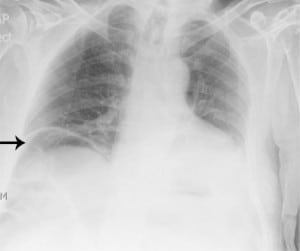| Author | Affiliation |
|---|---|
| Rosa F. McNamara, MCEM, MRCSEd(A&E), MRCPI | Cork University Hospital, Emergency Department, Wilton, Cork, Ireland |
| Stephen Cusack, FCEM, FRCSEd(A&E) | Cork University Hospital, Emergency Department, Wilton, Cork, Ireland |
| Patrick Hallihan, MRCS | Cork University Hospital, Department of Surgery, Wilton, Cork, Ireland |
A 58-year-old man presented to the Emergency Department with a two-day history of vomiting, diarrhea and intermittent central abdominal pain. His background history was significant for peptic ulcer disease. On examination there was diffuse abdominal tenderness, and a fecal occult blood test was positive. A departmental chest radiograph had appearances suggestive of a pneumoperitoneum, with an elevated right hemidiaphragm and subdiaphragmatic free air. The patient was referred to the surgical team for management of a suspected perforated duodenal ulcer.
Subsequent CT imaging of thorax and abdomen revealed hepato-diaphragmatic interposition of the transverse colon, as well as extensive colitis. He was managed conservatively and discharged home well after four days.
Chilaiditi’s sign is the appearance of free air under the diaphragm caused by interposition of the transverse colon between the liver and diaphragm. It is usually asymptomatic and is an incidental finding. It is estimated to occur in 0.25% to 0.28% of the general population1 and was first described by Demetrious Chilaiditi in 1910.2 When the sign is observed in association with symptoms such as abdominal pain or vomiting it is termed Chilaiditi’s syndrome. It is in this scenario that the radiographic findings may be mistaken for pneumoperitoneum, as occurred in this case.

Footnotes
Supervising Section Editor: Sean Henderson, MD
Submission history: Submitted September 29, 2009; Accepted October 8, 2009
Full text available through open access at http://escholarship.org/uc/uciem_westjem
Address for Correspondence: Rosa McNamara, MRCPI, MRCSEd(A&E), MCEM. Department of Emergency Medicine,Cork University Hospital, Wilton, Cork,Ireland
Email rosa.mcnamara@hse.ie
Conflicts of Interest: By the WestJEM article submission agreement, all authors are required to disclose all affiliations, funding sources, and financial or management relationships that could be perceived as potential sources of bias. The authors disclosed none.
REFERENCES
1. Risaliti A, DeAnna D, Terrosu G, et al. Chilaiditis’s syndrome as a surgical and non surgical problem. Surg Gynecol Obstet. 1993;176:55–58. [PubMed]
2. Chilaiditi D. Zur Frage der Hapatoptose und Ptose in allgemeinen im Auschluss an drei FŠlle von temporŠrer partieller Leberverlagerung. Fortschritte auf dem Gebiete der Roentgenstrahlen.1910;11:173–208.


